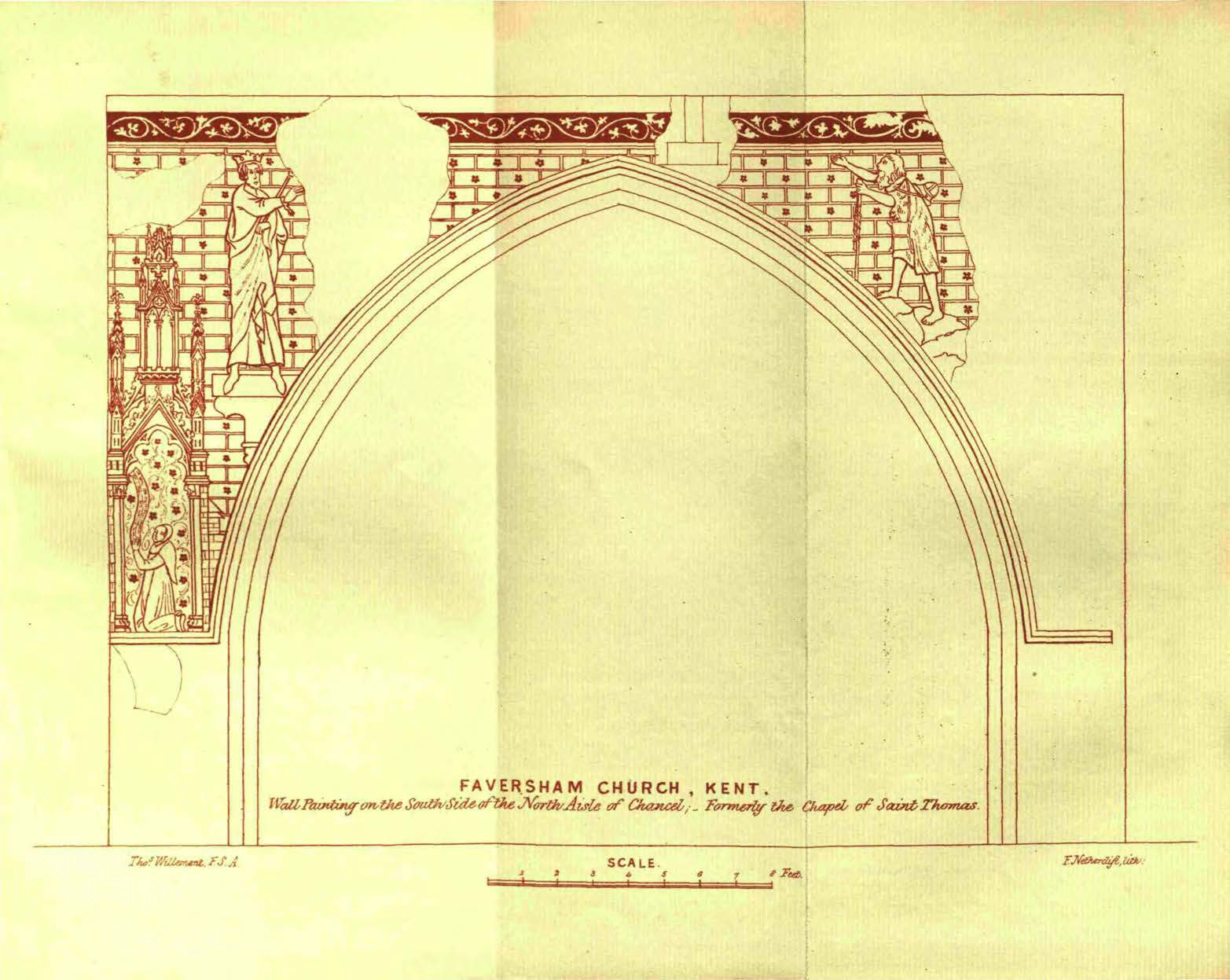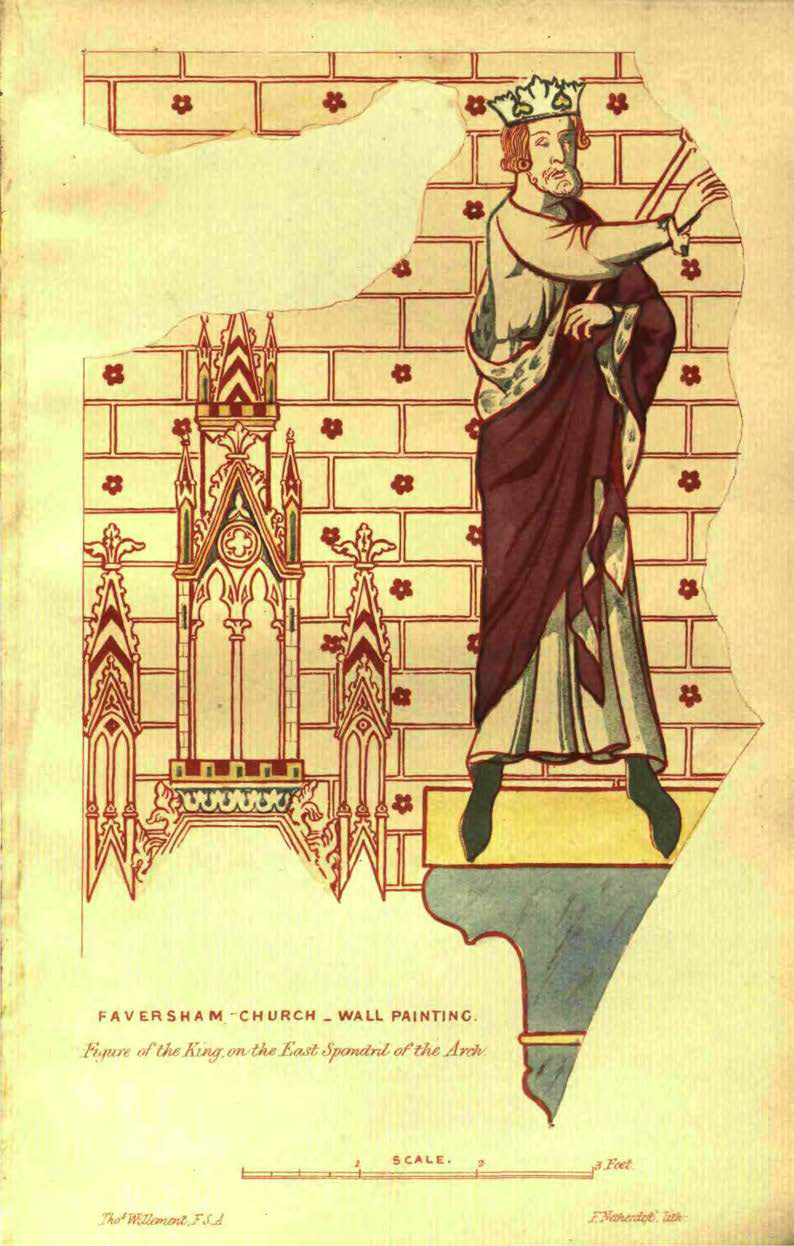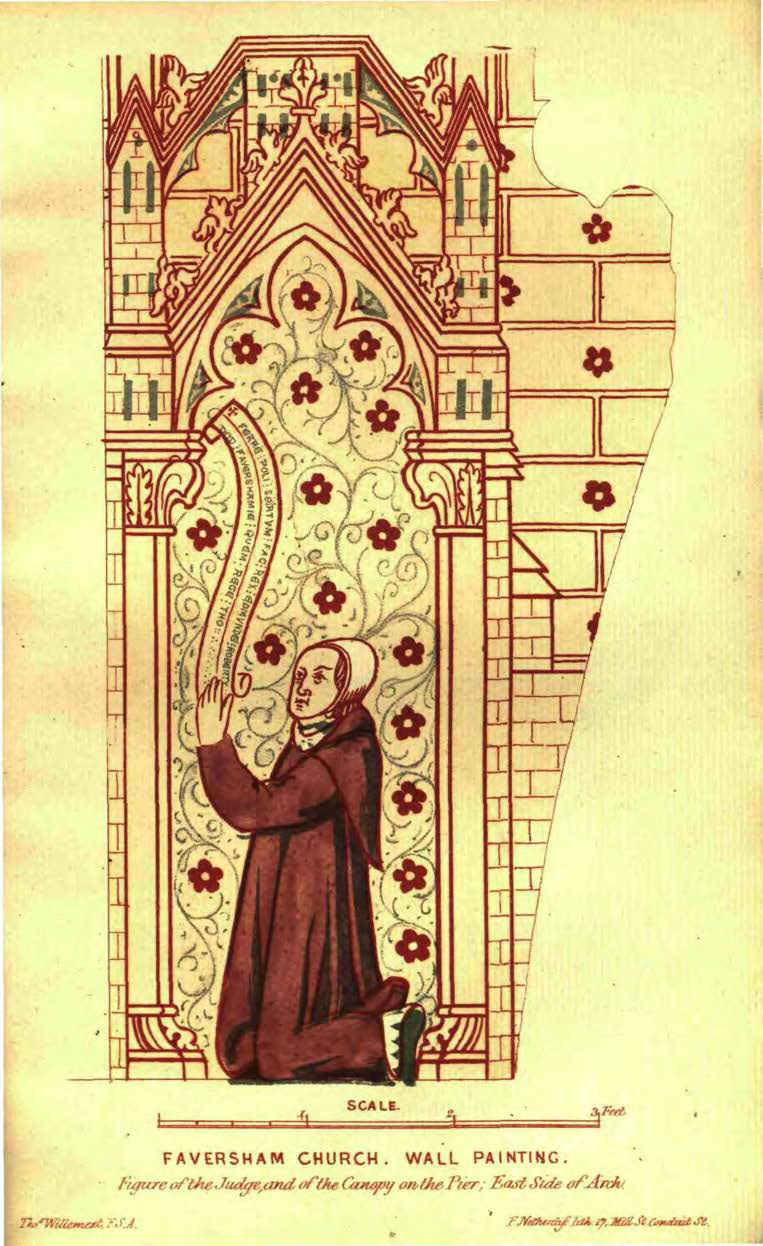Faversham Church Kent
BY THOMAS WILLEMENT, ESQ., F.S.A.
In the year 1851, during some alterations in this church, part of the walls, towards the eastern end of the aisles, was then cleared of many repeated coats of whitewash, and the removal of these brought into view considerable remains of wall-painting; they were generally in detached portions, but showing that the whole of the walls had been formerly thus decorated throughout.
The most perfect remains are shown on the drawings which accompany this paper, and were all found on the north side of the south wall of the north aisle of the chancel, touching the east end. Commencing from the east wall, on a pier, is the kneeling figure of a Judge looking towards the spot where formerly stood the altar of St. Thomas-a-Becket; he is clothed in a long scarlet robe, lined with minever, having on his head the white "coyf," tied beneath his chin. In his uplifted hands he holds a scroll, on which is an inscription in uncial letters, arranged in two lines; the words of this inscription will be referred to hereafter. He is represented as within a niche, above which arises a rich and lofty tabernacle.
There are some remains of painting at the east end of this aisle, but these have been nearly effaced by the subsequent introduction of a perpendicular window. On an octagonal column in the north transept, there yet remains, in a tolerably perfect state, a series of subjects illustrative of the life of the Virgin; they are well drawn, on alternate grounds of blue and red.

From this pier opens a large pointed arch into the chancel, and on the dexter spandrel of this arch stands painted the whole-length figure of a king, royally vested and crowned, holding in his left hand a sceptre, his right hand and arm being extended towards an opposite figure of a pilgrim.
The figure of the pilgrim, on the sinister spandrel of the arch, is of smaller dimensions than that of the king. He is bearded; his arms and legs uncovered, but his body clothed in a garment formed of sheepskins, the tufts of wool being shown upon it. He carries in his left hand, or is, rather, supported by his palmer's staff or bourdon, to which is attached, by a strap, a branch of the Holy Palm. His head-covering, a large hat, hangs, by a cord passing across his chest, at his back. His scrip is towards the front of his figure, strapped together, and the straps passing over his shoulders. His right hand and arm are extended to their full length, towards the opposite figure of the king, either in invocation or to receive the gift that the monarch might have held towards him. This figure appears to be climbing over rough and difficult ground, while the king stands on a solid base, which may be supposed to represent the platform of his throne.
The general background of these two figures is divided by double red lines into regular courses and blocks, and in the centre of each block is painted a red flower of five leaves, the centres pierced. Above the whole, a little below the oak ceiling of the aisle, is painted, on a red ground, a bold and flowing branch of fig-tree and its leaves, generally in a perfect state, and forming a graceful termination to the painting on the wall.
To return to the inscription on the scroll held by the kneeling figure of the Judge. Although even at its first discovery it was not perfectly clear, and that at the latter end of both lines some letters were obliterated, it appears to have been thus:
FERRE : POLI : SERTV.M:: FAC: REX: EDMVNDE : ROBERTVM:
DOD: FAVERSHAMIE: QVEM: REGE: THOMA: PIE:
and may be interpreted thus: "O King Edmund, cause Robert Dod, of Faversham, to bear the crown of Heaven, whom, O pious Thomas, do thou guide."
The exact meaning of this inscription, and the cause of such an invocation in favour of Robert Dod, appears at present extremely doubtful. Robert Dod himself is not to be found in the list of those who were judges, nor was he even a mayor of Faversham, as the records of that borough evidence. Whom then does the kneeling figure represent? The daughter and heiress of Robert Dod, of Faversham, was married to Richard de Faversham, whose father, Thomas de Faversham, was a judge, and Lord of Graveney. It is a mere supposition, but this Robert Dod might, by some act or grant, have benefited those pilgrims who, on their way to the great shrine of St. Thomas at Canterbury, halted at Faversham, to pay their devotions at the altar dedicated to him in the church of Faversham, close to which this memorial of their benefactor was placed; or that he had himself performed some more than ordinary pilgrimage himself; and that the kneeling figure of the judge represented his relative Thomas de Faversham, who had survived him, and addresses this invocation to the peculiar saints worshipped in this Chapel, in token of Robert Dod's good works. The style of the architectural canopy is evidently of the fourteenth century, and coeval with these persons.



1. Weever tells us that in his time there remained, in one of the windows of Graveney church, the arms of Faversham, underwritten "Tho... Faversham Justiciar. et Johna ux. ej."
2. That part of the church where the painting remains, is known to have contained the chapel of St. Thomas-a-Becket. In an inventory of goods and ornaments of the parish church of Faversham, 4 Hen. VIII., it is stated that "In Saynt Thomas Chapelle" there were "Imprimis a Chese-byll of purple damask, with the apparell for the Preest. Item, a clothe of arras with gold, for Saynt Thomas's auter, of the same. Item, two greene curtayns of sarsenett, for the same awter, fringed at the ends. Item, a steyned clothe, with a pictor of Saynt Thomas." The connection of St. Thomas and St. Edmund in this chapel, is shown by a bequest of Robert Fale, of Faversham, in 1529, viz. "To the light of St. Edmund in S. Thomas chapel, one Cowe."
